|
1 - The Gold Of The Gods
To me this is the most incredible, fantastic story of the century.
It could easily have come straight from the realms of Science
Fiction if I had not seen and photographed the incredible truth in
person. What I saw was not the product of dreams or imagination, it
was real and tangible.
A gigantic system of tunnels, thousands of miles in length and built
by unknown constructors at some
unknown date, lies hidden deep below the South American continent.
Hundreds of miles of underground passages have already been explored
and measured in Ecuador and Pent. That is only a beginning, yet the
world knows nothing about it.
On July 21, 1969, Juan Moricz, an Argentine subject, deposited a
legal title-deed (Fig. 1) signed by several witnesses with Dr.
Gustavo Falconi, a notary in Guayaquil. The deed sets out Moricz’s
claim to be the discoverer of the tunnels as far as the Republic of
Ecuador and posterity are concerned. I had this document, which was
written in Spanish, translated by a UN interpreter.
I quote the most
important parts of it at the beginning of this incredible story of
mine:
“Juan Moricz, Argentine citizen by naturalization, born in Hungary,
Passport No. 4361689 ...
“I have discovered objects of great
cultural and historical value to mankind in the Province of Morona-
Santiago, within the boundaries of the Republic of Ecuador.
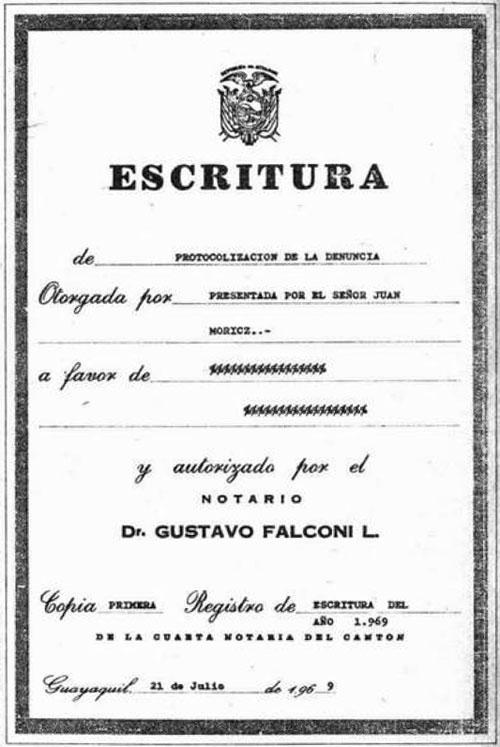
Fig. 1.
With the issue of this notarial title-deed on July 21. 1969,
the caves beneath Ecuador became the property of Juan Moricz.
Moricz
put them under state control which will smooth the way for future
research.
“The objects consist mainly of metal plaques inscribed with what is
probably a resume of the history of a lost civilization, the very
existence of which was unsuspected by mankind hitherto. The objects
are distributed among various caves and are of many different kinds.
I was able to make my discovery in fortunate circumstances ... In my
capacity as a scholar, I was carrying out research into the folklore
and the ethnological and linguistic aspects of Ecuadorian tribes ...
“The objects I found are of the following kinds:
1. Stone and metal objects of different sizes and colors.
2. Metal plaques (leaves) engraved with signs and writing.
These form a veritable metal library which might contain a synopsis
of the history of humanity, as well as an account of the origin of
mankind on earth and information about a vanished civilization.
“The
fact of my discovery has made me the legal owner of the metal
plaques and other objects in accordance with Article 665 of the
Civil Code.
“However, as I am convinced that the objects, which were not found
on my own land, are of incalculable cultural value, I refer to
Article 666, according to which the treasure I discovered remains my
personal property, but subject to State control.
“I beg you, most excellent President of the Republic, to appoint a
scientific commission to verify the contents of this document and
assess the value of the finds ...
“I am prepared to show such a
commission the exact geographical position and site of the entrance,
as well as the objects I have discovered so far...”
Moricz stumbled on the underground passages in June, 1965, during
his research work, in which he was ably assisted by Peruvian Indians
who acted as skillful intermediaries between him and their tricky
fellow tribesmen. Being cautious by nature and skeptical as
befitting a scholar, he kept silent for three years. Not until he
had covered many miles of underground passages and found all kinds
of remarkable objects did he ask President Velasco Ibarra for an
audience in the spring of 1968.
But the President of a country in
which nearly all his predecessors had been deposed by rebellions
before the expiry of their term of office, had no time for this lone
wolf with his incredible tale of discovery. The palace flunkies
found the obstinate archaeologist very charming and assured him,
after long delays, that the President would be glad to receive him
in a few months’ time, but Moricz was finally told he could not have
an audience until 1969. Disillusioned and embittered he withdrew to
his subterranean retreat.
I first met Juan Moricz on March 4, 1972.
His lawyer, Dr. Pena Matheus of Guayaquil, had been trying to get in
touch with him by telegram and telephone for two whole days. I had
settled down in Dr. Pena’s office with plenty to read, somewhat
nervous, I must admit, because according to all reports Moricz was a
very difficult man to approach and had a deep aversion to anyone
connected with the writing profession. Finally one of the telegrams
readied him. He telephoned me.
He knew my books! “I don’t mind talking to you,” he said.
On the night of March 4 he stood there, a wiry, deeply tanned man in
his mid-forties, with gray hair (Fig. 2). He is one of those men who
has to be drawn out, because he himself is anything but talkative.
My vehement, insistent questions amused him. Gradually he began to
give a factual and very expressive description of his tunnels.
“I can’t believe it!” I cried.
“Nevertheless, it’s just as he says,” said Dr. Pena, “I’ve seen it
all with my own eyes.”
Moricz invited me to visit the caves.
Moricz, Franz Seiner (my traveling companion) and I climbed into a
Toyota jeep. During the twenty-four hour drive to the site we took
turns at the wheel. Before we entered the caves, we took the
precaution of having a good sleep. When the dawn sky announced the
advent of a hot day, our adventure began.
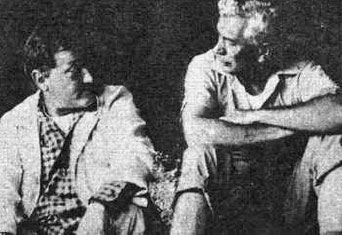
Fig. 2.
Erich von Daniken with Juan Moricz, the discoverer of the
caves,
in front of a side-entrance to the mysterious underworld.
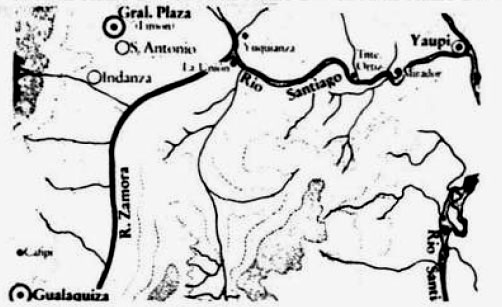
Fig. 3.
The secret entrance to the hidden tunnel system, which is
guarded by hostile Indians,
is situated within the triangle formed
by
the three towns Gualaquiza, San Antonio and Yaupi in the province
of Morona-Santiago.
The entrance, cut in the rock and wide as a barn door, is situated
in the province of Morona-Santiago,
in the triangle formed by Gualaquiza-San Antonio-Yaupi (Fig. 3), a
region inhabited by hostile
Indians. Suddenly, from one step to another, broad daylight changed
to pitch darkness. Birds fluttered past our heads. We felt the
draught they created and shrank back. We switched on our torches and
the lamps on our helmets, and there in front of us was the gaping
hole which led down into the depths. We slid down a rope to the
first platform 250 feet below the surface. From there we made two
further descents of 250 feet.
Then our visit to the age-old
underworld of a strange unknown race really began. The passages
(Fig. 4) all form perfect right angles. Sometimes they are narrow,
sometimes wide. The walls are smooth and often seem to be polished.
The ceilings are flat and at times look as if they were covered with
a kind of glaze. Obviously these passages did not originate from
natural causes-they looked more like contemporary air-raid shelters!
As I was feeling and examining ceilings and walls, I burst out
laughing and the sound echoed through the tunnels. Moricz shone his
torch on my face:
“What’s wrong? Have you gone crazy?”
“I’d like to see the archaeologist with the nerve to tell me that
this work was done with hand-axes!”
My doubts about the existence of
the underground tunnels vanished as if by magic and I felt
tremendously happy. Moricz said that passages like those through
which we were going extended for hundreds of miles under the soil of
Ecuador and Peru.
“Now we turn off to the right,” called Moricz.
We stood at the entrance to a hall as big as the hangar of a Jumbo
Jet. It could have been a distribution center or a storeroom, I
thought. Galleries leading in different directions branched off it.
When I tried to use my compass to find out where they led, it went
on strike. I shook it, but the needle did not move. Moricz watched
me:
“It’s no use. There is radiation down here that makes it impossible
to get a compass bearing. I don’t know anything about the radiation,
I have only observed it. It’s really a job for physicists.”
On the
threshold of a side passage a skeleton lay on the ground It looked
as if a doctor had carefully prepared it for an anatomy lesson, but
in addition had sprayed it all over with gold dust.
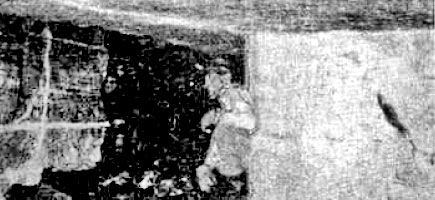
Fig. 4.
Inside the artificial tunnel system, which is haunted by
swarms of birds.
In two places which I
measured the droppings were 32-35 inches deep.
The ceilings are
flat; the walls form right angles and
are often covered with a kind of glaze.
The bones gleamed in the light of our torches like solid gold.
Moricz told us to switch off our torches and follow him slowly. It
was very quiet; all I could hear was our footsteps, our breathing
and the whir of the birds, to which we rapidly grew accustomed. The
darkness was blacker than the darkest night.
“Switch on your torches,” shouted Moricz.
We were standing dumbfounded and amazed in the middle of a gigantic
hall. Moricz, the proud discoverer, had prepared the effect as
cleverly as the citizens of Brussels, who use the same trick when
confronting foreign tourists with their Grand Place, perhaps the
most beautiful square in the world. This nameless hall into which
the seventh passage leads is intimidatingly large, but very
beautiful and nobly proportioned. We were told that the ground plan
measures 153 by 164 yards, It went through my mind that these were
almost the dimensions of the Pyramid of the Moon at Teotihuacan and
that in both cases no one knows who the builders, the brilliant
technicians, were.
There was a table in the middle of the room.
Was it really a table? Presumably, for there were seven chairs along one side.
Were they chairs? Apparently they were. Stone chairs?
No, they did not have the same cold feeling as stone. Were they made of wood?
Definitely not. Wood would never have lasted for thousands of years.
Were they made of metal? I did not think so.
They felt like some kind of plastic, but they
were as hard and heavy as steel. There
were animals behind the chairs: saurians, elephants, lions,
crocodiles, jaguars, camels, bears, monkeys,
bison, and wolves, with snails and crabs crawling about between
them. Apparently they had been cast
in molds and there was no logical sequence about their arrangement.
They were not in pairs, as is
usual in pictures of Noah’s Ark. They were not arranged by species,
as zoologists prefer. Nor were
they in the hierarchical order of natural evolution used by
biologists. They simply stood there peacefully, as if the laws of
nature did not apply.
The whole thing was like a fantastic zoo and what is more all the
animals were made of solid metal. Also in this hall was the most
precious treasure of all, the metal library mentioned in the
notarial title-deed, although I could never have guessed what it was
really like from reading about it. The library of metal plaques was
opposite the zoo, to the left of the conference table. It consisted
partly of actual plaques and partly of metal leaves only millimeters
thick. Most of them measured about 3 feet 2 inches by 1 foot 7
inches.
After a long and critical examination, I still could not
make out what material had been used in their manufacture. It must
have been unusual, for the leaves stood upright without buckling, in
spite of their size and thinness. They were placed next to each
other like bound pages of giant folios. Each leaf had writing on it,
stamped and printed regularly as if by a machine. So far Moricz has
not managed to count the pages of his metal library, but I accept
his estimate that there might be two or three thousand.
The characters on the metal plaques are unknown, but if only the
appropriate scholars were told of the existence of this unique find
now I am sure that they could be deciphered comparatively quickly in
view of the wealth of possibilities for comparison.
No matter who the creator of this library was, nor when he lived,
this great unknown was not only master of a technique for the
“mass-production of metal folios in vast numbers-the proof is
there-he also had written characters with which he wanted to convey
important information to beings in a distant future. This metal
library was created to outlast the ages, to remain legible for
eternity. Time will show whether our own age is seriously interested
in discovering such fantastic, awe-inspiring secrets.
Is it prepared to decipher an age-old work even if it means bringing
to light truths that might turn our neat but dubious world picture
completely upside down?
Do not the high priests of all religions ultimately abhor
revelations about prehistory that might replace belief in the
creation by knowledge of the Creation?
Is man really prepared to admit that the history of his origin was
entirely different from the one which is instilled into him in the
form of a pious fairy story?
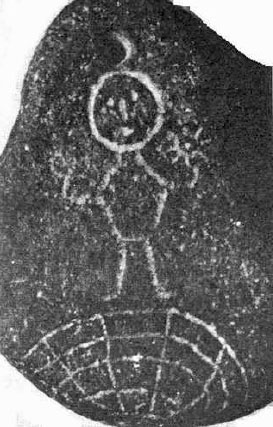
Fig. 5
An amulet dating to around 9000-4000 B.C. A being stands on
the terrestrial globe.
How did Stone Age men know that the earth was
round, a discovery that was not made until much later?
Are
pre-historians really seeking the unvarnished truth without
prejudice and partiality?
No one likes to fall off a skyscraper he has built himself.
The walls and passages of the tunnel system were bare. There were no
paintings like those in the deep burial chambers in the Valley of
the Kings near Luxor, no reliefs of the kind found in prehistoric
caves at sites all over the world. Instead there were stone figures
which we bumped into at every step. Moricz owns a stone amulet 4 ½
inches high and 2 ½ inches wide.
The obverse (Fig. 5) is engraved
with a being with a hexagonal body and round head that might have
been drawn by a child. The figure holds the moon in its right hand
and the sun in its left hand. Admittedly, that is not particularly
surprising, but-it stands with both feet firmly on the terrestrial
globe! Surely that is a clear proof that even in times when the
first primitive drawings were scratched on stone, a chosen few of
our first ancestors already knew that we lived on a globe! The
reverse shows a half moon and the radiant sun.
Without any doubt,
this stone amulet found in the tunnels seems to me to be a proof
that they were already in existence in the Middle Paleolithic
(9000-4000 B.C.).
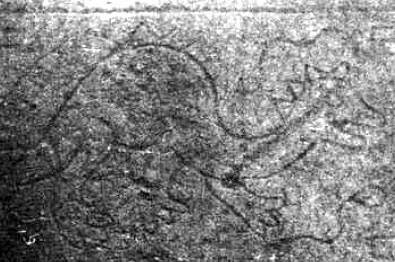
Fig. 6.
If this engraving by a prehistoric stonemason represents a
dinosaur, there’s something wrong!
These animals lived 135,000,000 years ago.
There is another engraving on a stone plaque (Fig. 6), 11 ½ inches
high and 1 foot 8 ½ inches wide, this time depicting an animal. I
suspect that it is a representation of a dinosaur. This extinct
prehistoric animal moved on land with the help of long hind legs as
shown in the engraving. Even its gigantic size dinosaurs were as much
as 65 feet long-can still be sensed in the foreshortened squat
version of the body, and the feet with three toes strengthen my
suspicion. If my identification of this picture is correct, it will
be most uncanny.
This extinct reptile lived in the earth’s Middle
Ages during the Upper Cretaceous, i.e. 135,000,000 years ago, when
the modern continents began to assume their present configuration. I
am not going to speculate any further. I simply ask this question:
what intelligent, thinking being ever saw a saurian?
In front of us lay the skeleton of a man, carved out of stone (Fig.
7). I counted ten pairs of ribs, all anatomically accurate.
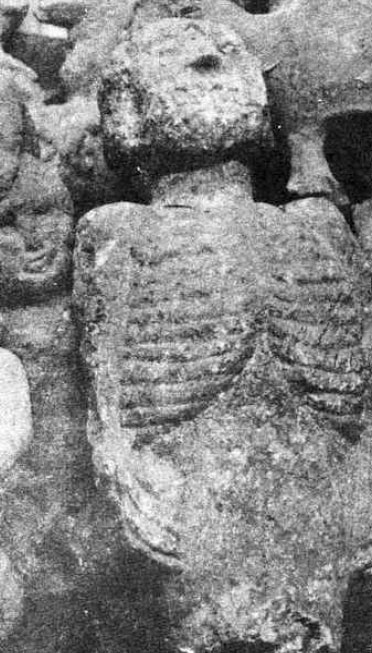
Fig. 7.
A skeleton carved out of stone
In an office, I beg your pardon, a square stone room, Moricz showed
me a dome (Fig. 8). Figures with dark faces stood like guards around
its circumference. They had hats on their heads and held spearlike
objects in their hands, as if they were ready to defend themselves.
Figures flew or floated through the air near the top of the dome. By
the light of my torch I discovered a skeleton crouched behind the
“Romanesque” entrance to the dome. It did not shock me, but what did
shock me was this model of a dome. Heinrich Schliemann discovered
the first dome when he excavated Mycenae, a fortress and town in the
northeast Peloponnese, from 1874 to 1876, and that dome was supposed
to have been built by the Achaeans at the end of the fourteenth
century B.C.
I actually learnt at school that the Pantheon in Rome,
built in Hadrian’s reign between A.D. 120 and 125, was the first
dome. But from now on I shall consider this piece of; stonework as
the oldest example of a dome.
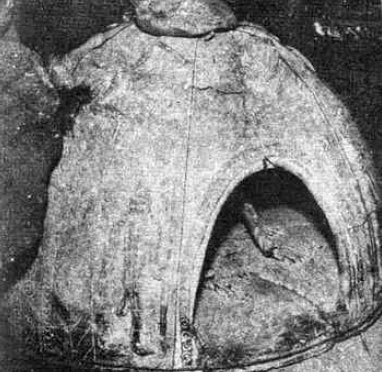
Fig. 8.
Probably the very first dome ever built.
What we were taught
at school and what we read in books are no longer valid.
A clown with a bulbous nose knelt on a stone plinth (Fig. 9). The
little fellow sported a helmet that covered his ears. Earphones like
those on our telephones were attached to the lobes of his ears. A
ring in relief, with a diameter of 2 inches and 2/5 inch thick, was
stuck to the front of the helmet. It was fitted with 15 holes, which
seemed to be admirably adapted for fitting plugs into. A chain hung
round his neck and it, too, had a ring with a number of holes in it
like those we use for dialing telephone numbers.
Other remarkable
features were the spacesuit accessories on the suit that the gnome
wore, and the gloves, in which his fingers were well protected
against dangerous contacts. I would not have paid any attention to a
winged mother figure, between whose arms knelt a slit-eyed child in
a crash-helmet, if I had not seen the identical figure (Fig. 10),
though in clay, during a visit to the American Museum in Madrid.
Whole books could and will be written about these tunnels and their
treasures. Among many other things, they will mention the 6-feet
high stonemason’s works, representing beings with three and seven
heads; the triangular plaques, with writing on them as if
schoolchildren had been making their first attempts at writing; dice
with geometrical figures on their six plane surfaces; the piece of
soapstone, 3 feet 8 inches long and 9 ¼ inches wide, which is curved
like a boomerang and covered with stars, etc.
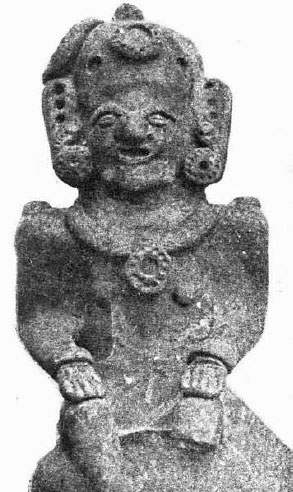
Fig 9.
Clown, divinity or space traveler?
The figure has such
obviously technical accessories that he could easily have been one
of a crew of cosmonauts.
Mouthpiece, sockets on his helmet-what does
it all mean?
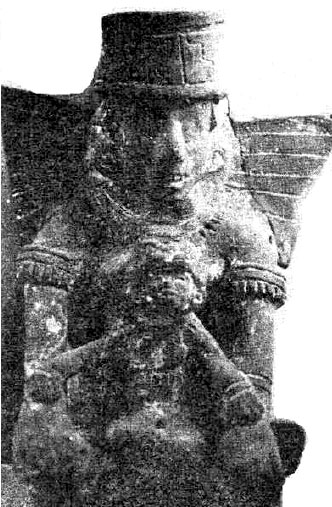
Fig. 10.
The identical winged mother figure to the one in the caves
in Ecuador
is on show in the American Museum in Madrid-but made of
clay!
No one knows who built the tunnels; no one knows the sculptors who
left behind these strange ambiguous works. Only one thing seems
clear to me. The tunnel builders were not the same men as the
stonemasons; their stark practical passages were obviously not meant
to be decorated. Perhaps they showed the underground vaults to a
chosen group and the latter fashioned in stone things they had seen
and heard and stored the results in the depths.
So far the entrance to this underground treasure-trove of human
history is known only to a few trustworthy people and it is guarded
by a wild Indian tribe. Indians lurk unseen in the undergrowth and
watch every movement made by strangers. Moricz has been accepted as
a friend by the chieftain of the cave guardians and three members of
the tribe who are occasionally in contact with civilization.
Once a
year, at the beginning of spring, on March 21, the chieftain climbs
down alone to the first platform in the underworld to offer ritual
prayers. Both his cheeks bear the same signs as are marked in the
rock at the entrance to the tunnels (Fig. 11). To this day the tribe
of tunnel guardians still make masks and carvings “of the men with
long noses” (gas masks?) and they tell, as Moricz knows, of the
heroic deeds of the “flying beings” who once came from heaven.
But
the Indians will not go into the tunnels for love or money.
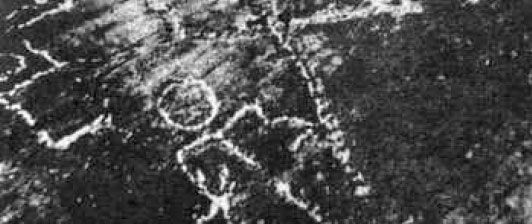
Fig. 11.
These markings are carved in the rock at the entrance to
the tunnel.
The chieftain of the tribe that guards the cave has
identical markings on both cheeks.
They are age-old Indian symbols.
“No, no,” they said to Moricz. “Spirits live down there.”
But it is a remarkable fact that Indian chiefs occasionally use gold
to pay the debts they have incurred with the civilized world or
present friends who have rendered their tribe a service with
precious gold objects from their five-hundred-year-old past.
On several occasions Moricz had stopped me taking photographs as we
passed through the tunnels. He kept on making different excuses.
Sometimes it was the radiation that would make the negatives
unusable, sometimes it was the flash which might damage the metal
library with its blinding light. At first I could not understand
why, but after a few hours underground I began to sense the reason
for Moricz’s strange behavior.
You could not get rid of the feeling
of being constantly watched, of destroying something magic, of
unleashing a catastrophe. Would the entrances suddenly close? Would
my flash ignite a synchronized laser beam? Would we never see the
light of day again? Childish ideas for men engaged on serious
investigation? Perhaps.
But if you had experienced what it was like
down there, you would understand these absurd ideas. Teams equipped
with modern technical aids will have to work down there to see
whether there are any dangers to be overcome or avoided. When I
first saw the pile of gold, I begged to be allowed to take just one
photo. Once again I was refused. The lumps of gold had to be levered
from the pile and that might make a noise and start stones falling
from the roof like an avalanche. Moricz noticed my frustration and
laughed.
“You’ll be able to photograph plenty of gold later, but not
in such vast quantities. Will that do?”
Today I know that the
biggest treasure from the dark tunnels is not on show in South
American museums. It lies in the back patio of the Church of Maria Auxiliadora at Cuenca in Ecuador, some 8,100 feet above sea level.
Father Crespi (Fig. 12), the collector of the treasure, which is
priceless just for its weight in gold, has been living in Cuenca for
forty-five years. He is accepted as a trustworthy friend of the
Indians, who during past decades fetched the most valuable gold,
silver and metal objects from their hiding places piece by piece and
gave them to him, and still do so today.
I had been warned beforehand that the good Father was fond of
pulling his visitors’ legs. I soon had a
taste of this. In all seriousness he showed me an object that was
obviously the lower part of a flatiron.
“Look,” he said, “that
proves that the Inca rulers had their trousers pressed even in those
days!”
We laughed and Father Crespi led us through his treasure
chambers. Room I houses stonemason’s work;
Room II contains Inca artifacts of gold, silver, copper and brass,
while Room III holds the gold treasure, which he very seldom shows
anyone, and then unwillingly.
Cuenca has a “Gold Museum” of its own,
but it cannot compare with Father Crespi’s.
The showpiece was a stele (Fig. 26), 20 ½ inches high, 5 ½ inches
wide and 1 ½ inches thick. Fifty-six different characters are
“stamped” on its 56 squares. I had seen absolutely identical
characters on the leaves in the metal library in the Great Hall!
Whoever made this metal stele used a code (an alphabet?) with 56
letters or symbols arranged to form writing. What makes this all the
more remarkable is the fact that hitherto it has always been claimed
that the South American cultures (Incas) possessed no alphabetical
writing or script with alphabetical characteristics.
“Have you seen
this lady?” asked Moricz.
She was 12 ½ inches high and naturally of solid gold. Her head was
formed of two triangles, whose planes seemed to have wings welded to
them. Coiled cables emerged from her ears; they were obviously not
jewelry, for the lady’s earrings were clipped to her ear lobes. She
had healthy, if triangular proportions, with well-formed breasts and
stood with legs apart. The fact that she had no arms did not mar her
beauty. She wore long, elegant trousers. A sphere floated above her
head and I felt that the stars on either side referred to her
origin. A star from a past age? A maiden from the stars?
Next came a brass discus, 8 ½ inches in diameter (Fig. 13). It
cannot have been a shield, as the archaeologists would catalog it.
For one thing it is too heavy, for another it has never had a
hand-hold on its smooth reverse side. I believe that this discus,
too, was intended to transmit information. It exhibits two stylized,
but incredibly accurate spermatozoa, two laughing suns, the sickle
of a waning moon, a large star and two stylized triangular men’s
faces. In the middle are small raised circles, arranged to give the
beholder visual pleasure, but apparently intended to produce a
different and more serious effect.
Father Crespi put a heavy copper
plaque in front of the camera.
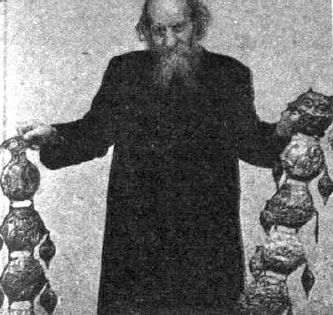
Fig. 12.
This is Father Carlo Crespi,
who collects and guards an
incredible treasure of gold and silver objects
in the back patio of
the Church of Mana Auxiliadora at Cuenca.
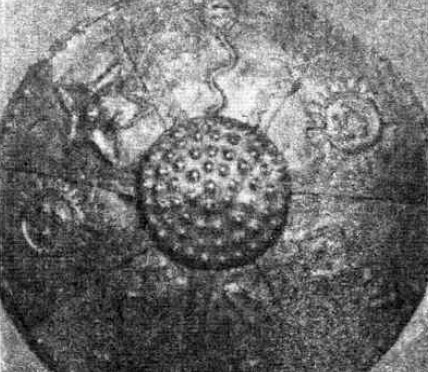
Fig. 13.
Heavy brass
discus, 8 ½ inches in diameter.
A precious and mysterious means of
conveying information, but certainly not a normal shield!
“Here is something special for you, my young friend. This piece
dates to the period before the Flood.”
Three creatures, holding a tall tablet with some signs on it, stared
at me. The pairs of eyes looked as if
they were peering from behind goggles. The upper left-hand monster
pointed to a sphere, the righthand
one was clad from head to foot in an overall, which was fastened at
the sides, and proudly wore a
three-cornered star on his head. Above the tablet with signs floated
two winged spheres. What were
the monsters holding? Some kind of Morse code, dots, dashes, SOS’s?
A switchboard for electric
contacts? Anything is possible, but I suspect technical analogies
rather than letters on this tablet. And
according to the Father, who has been given special Vatican
permission to carry out his archaeological research, it does date to
the period before the Flood.
Take my word for it, when you catch sight of the treasures in the
back patio of Maria Auxiliadora, you have to be very strong-willed
not to get “gold-drunk.” But it was not the large amounts of gold
that impressed me, it was the representation of stars, moons, suns
and snakes that gleamed on hundreds of metal plaques-nearly all of
them unequivocal symbols of space travel.
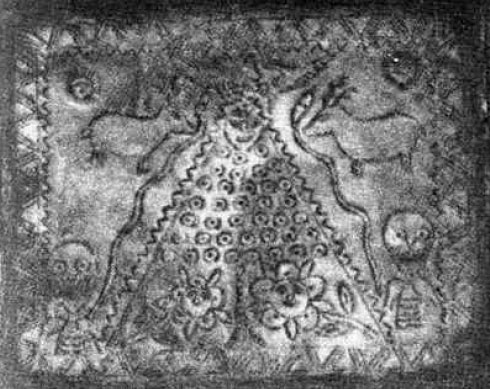
Fig. 14.
The dominant
feature of this copper plaque is a pyramid on which snakes writhe
upwards.
Do the circles indicate the number of astronauts buried
inside it?
I picked some exceptionally photogenic examples of such pictures out
of what is presumably the lost heritage of the Incas, who were very
familiar with the snake sign and used it decoratively in
representations of their ruler, the “Son of the Sun.”
Here they are:
A relief with a pyramid (Fig. 14). The steep sides are bordered by
snakes. There are two suns, two astronaut-like monsters, two
deer-like animals and some circles with dots in them. Do the circles
indicate the number of space travelers buried inside the pyramid?

Fig. 15.
Notable features of this solid gold pyramid:
the snakes are
where they belong - in the sky - and at its foot are elephants,
which
the artists could not possibly have seen in South America around
12,000 B.C.
The writing on the lower edge of the pyramid is unknown
and has not been deciphered so far.
Another plaque with a pyramid (Fig. 15). Two jaguars, symbols of
strength, have their paws on the sides. There are obvious signs of
writing at the foot of the pyramid. To the right and left we see
elephants, which lived in South America about 12,000 years ago
before any civilizations or cultures are supposed to have existed.
And the snakes are at last where they ought to be, in the sky. No
one can deny that snakes and dragons have a special place in all
myths about the creation. Even a scientist such as Dr. Irene Sanger-Bredt,
who is an engineer in the aircraft and space industries, puts the
following question in her book ‘Ungeloste Ratsel der Schopfung’
(Unsolved Puzzles of the Creation):
“Why does the dragon motif play such an important part in the
figurative representations and myths of the ancient Chinese,
Indians, Babylonians, Egyptians, Jews, Germans and Mayas?”
In her
answer, Dr. Sanger-Bredt thinks it probable that snake and dragon
symbols must have some connection with the creation and the
universe.
In his book The Masters of the World, Robert Charroux quotes ancient
texts to show that gleaming snakes which floated in the air have
occurred everywhere, that the Phoenicians and Egyptians raised
snakes and dragons to the godhead, and that the snake belonged to
the element of fire, because in it there is a speed which nothing
can exceed, because of its breath.
Charroux quotes Areios of
Heracleopolis literally:
“The first and highest divinity is
the
snake with the sparrow-hawk head; when it opens its eyes, it fills
the whole of the newly created world with light; when it shuts them,
the darkness spreads over everything.”
The historian Sanchuniaton, who lived in Beirut circa 1250 B.C., is
reputed to have recorded the mythology and history of the
Phoenicians. Charroux quotes this passage from him:
“The snake has a speed which nothing can exceed, because of its
breath. It can impart any speed it likes to the spirals it describes
as it moves ... Its energy is exceptional ... With its brilliance it
has illuminated everything.”
These are not descriptions of the sort of snakes that intelligent
human beings saw crawling about on the ground.
But why have snakes so persistently made their home in all the
creation stories and myths? For once, I shall obey the call of the
scholars, according to whom our primeval ancestors can only be
understood in terms of their own mental level at the time when they
lived, and use simple depth psychology.
If our ancestors saw a large unusual bird, they described what they
had actually seen, as the concept for it was included in their
limited vocabulary. But how could they have described a phenomenon
in the firmament seen for the first time for which words and
concepts were lacking? Probably the alien cosmonauts were not
over-particular about casualties during their first landing on our
planet. Perhaps spectators were hit and scorched by the red-hot
trail of a jet during the landing or destroyed by the thrust of a
rocket on the return launching. There was absolutely no technical
vocabulary for an eyewitness account of this terrifying yet
grandiose event.
The unknown gleaming (metal) thing that landed or took off,
snorting, smelling and kicking up a din was obviously not a bird. So
they described what they had seen-using current ideas -as a thing
‘like a dragon” or ‘like a great gleaming bird,” or, because it was
so far beyond their comprehension, as “a feathered fire-breathing
serpent.” Horrified by what they had experienced, fathers told their
sons and they told their grandsons for centuries and millennia about
the terrifying apparition of the dragon or snake. With the passage
of time the eye-witness account using a makeshift vocabulary
gradually became vaguer. Sometimes the fire-breathing dragon would
loom largest, sometimes the flying snake, until they assumed their
predominant position in mythology.
There are countless snakes on the gold plaques in the tunnels
underneath Ecuador and Peru, and on Father Crespi’s treasures:
snakes crawling up pyramids, striving for the summits, flying in the
heavens with a trail of fire or lying on the heads of the gods. But
neither here nor elsewhere do we see a single snake doing the things
men have always seen them do-wriggling through the grass, hanging
from a tree, swallowing a mouse or writhing about in the mud with
other snakes. Everywhere dragons and even more so snakes stand as
symbols for phenomena from the cosmos.
What do the archaeologists say about all this?
The snake was a symbol of immortality. Why? Because our observant
ancestors had noticed that the reptile shed its skin and constantly
emerged from it renewed. Surely our ancestral students of behavior
observed that in the end the snake died just the same?
The snake was an expression of agility and maneuverability. Would
not birds or butterflies have been better models than this miserable
creature crawling on the ground? The snake was an emblem of
fertility and was honored as such by primitive peoples-all of whom
were afraid of snakes. A strange stimulus to the production of
offspring. Forest dwellers were afraid of the snake and so they
chose it as a god. Lions, bears or jaguars are much more
dangerous-snakes only seize animals that they want to eat, they do
not attack indiscriminately.
Moses gets nearer to the truth (Genesis 3:1) For him the snake is
the messenger of disaster much as in the North Germanic Midgard of
early times, that “farm” between heaven and earth, the snake coils
round the property as the personification of danger and destructive
power.
Prehistoric evidence shows:
-
that snakes and dragons are connected with the creation of men
-
that snakes and dragons are connected with the stars
-
that snakes
can fly
-
that snakes have an unpleasant fiery breath
So far there has been no profound investigation of the origin of
snakes in myths and legends in archaeological and ethnological
literature. Experts could fill this gap. I gladly place my archives
at their disposal.
Father Crespi has partially stacked his metal plaques by motifs, for
example those with pictures of pyramids. I took a close look at more
than 40 and some of them are reproduced in this book. All the
pyramid engravings have four things in common:
-
a sun, but more
frequently several suns, is depicted above the pyramid
-
snakes are
always flying next to or over the pyramid
-
animals of various
kinds are always present
-
two concentric circles in varying
numbers, but always of the same size, are engraved near the
pyramids. I counted between 9 and 78
These concentric circles, actually a large dot inside a circle, are
not only found here at Cuenca, but in
all kinds of prehistoric cave paintings and reliefs. Until now these
dotted circles were and still are
interpreted as solar symbols. I have my doubts about this. The sun
(with laughing face or a corona of
rays) always has a place reserved for it in addition; in fact,
frequently several suns are shining. If the
suns are depicted so unmistakably, we ought to ask ourselves what
the circles have to tell us. Do they
indicate the numbers of astronauts observed?
When they occur near
the pyramid, are they an
indication of the number of alien gods buried inside them? Or do
they mark the sequence of
explosions observed? I believe that the dotted circles are purely
and simply a form of reckoning. What
I mean cannot be more graphically depicted than in the cave painting
which was discovered in the
Kimberley Ranges,
Australia (Fig. 16).
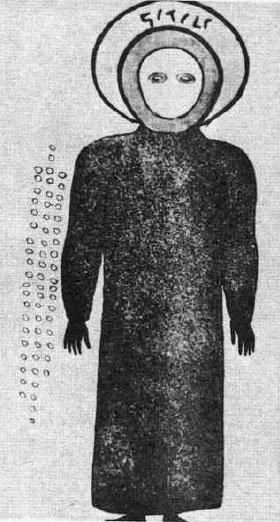
Fig. 16.
Cave painting of a god, found in the Kimberley Ranges,
Australia.
No one can seriously interpret the 62 small circles as
“suns”!
The god’s “halo” symbolizes
the sun, but 62 circles are painted
next to the figure. Are these simply meant to be small suns? There
are all kinds of possible questions and I find any answer more
likely than the claim that the dotted circles, even when they are
next to obvious pictures of the sun, represent yet more solar
symbols. Our prehistoric message transmitters did not make things
all that easy for us. In addition animals are always present.
I
cannot resist one more taunt. At the foot of the pyramid made with
great accuracy of neat blocks stand two delightful elephants. That’s
nice.
Archaeologists have dug up elephants’ bones in North America and
Mexico, but they were dated to before 12,000 B.C. But elephants had
completely disappeared from the scene in South America in the age of
the Incas, whose culture, it is established, began around A.D. 1200.
So we must make a choice: either the Incas had received visitors
from Africa who drew elephants next to the pyramids for them or
these gold plaques are more than 14,000 years old (12,000 plus
2,000). The only answer is either / or.
I think that the pyramids stamped in metal from Father Crespi’s
treasure help to eliminate an academic
error. Until now scholars have asserted that both the pyramids in
South America and the Mayan
pyramids in Central America originated without any connection with
the Egyptian pyramids. In Egypt
the colossal structures were burial places, in the other hemisphere
simply grandiose edifices on the
upper platforms of which temples were built The gold plaques do not
exhibit a single flattened surface at the summit with a temple on
it!
They have the same pyramidal shapes as those
in Egypt. Who copied
from whom? Who were the first to build pyramids, the Incas or the
Egyptians? They cannot be posthumous forgeries. Firstly forgers
would have needed more gold than there is in Fort Knox, secondly,
they would have needed to employ a whole corps of artists with a
far-reaching knowledge of the ancient peoples and their cultures,
and thirdly it would have been necessary to continue making the
grandiose forgeries right through the Inca period, whenever that
was.
I should like to know what tricks scholars will use to displace
this fabulous metal treasure of inestimable archaeological and
historical value, which is described here for the first time, from
the period into which it does not seem to fit. Could it be that all
pyramids everywhere in the world had the same master-builders?
Characters can often be made out on the illustrated objects from
Cuenca. Are they older than all previously known forms of writing?
Cuneiform writing in Phoenicia and hieroglyphics in Egypt are
supposed to have originated circa 2000 B.C. from a mixture of
Egyptian and Babylonian influences. Circa 1700 B.C. the
pre-Israelite population of Palestine is supposed to have created a
simplified syllabic script with about 100 signs, composed of a
mixture of both the foregoing kinds of writing. The Phoenician
alphabet with 22 signs (Fig. 17) developed from this shortly before
1500 B.C.
With the addition or transformation of signs all the
alphabets in the world derive from the Phoenician one. About 1000
B.C. the Greeks adopted two variations of the Phoenician alphabet;
they left out some expendable consonantal signs and used them to
represent vowels, and that is how the first phonetic script in the
world originated.
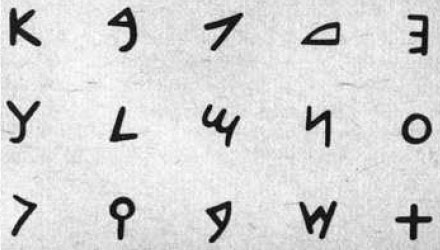
Fig. 17.
Phoenician alphabet, 12th-10th century
B.C.
All the alphabets in the world originated from the Phoenician
alphabet with its 22 signs. At least that was the accepted theory
until now. For generations all the scholars specializing in this
field have claimed that neither the pre-Inca peoples nor the Incas
themselves had an alphabetical script. They marveled at the Indians’
civilized achievements, their road-building and water-supply
systems, the accurate calendar, the Nazca culture, the buildings at
Cuzco, their highly developed agriculture, an (oral) postal service
that worked and many other things. The one thing they would not
credit them with was writing or an alphabet.
Professor Thomas Barthel, Director of the Folklore Institute of
Tubingen University, told the 39th International Congress of
American Studies at Lima that he had succeeded in establishing 400
signs of an Inca writing. He could interpret the meaning of 50 of
them and read 24. It was not an alphabetical script. Peruvian and
German scholars spoke of “attractive patterns and ornaments” which
they thought were akin to writing.
In January, 1972 a veritable bomb exploded on the Congress for
Andean Archaeology at Lima. The Peruvian ethnologist Dr. Victoria de
la Jara backed up ten years of research work with proof that the
Incas really did have a script. She said that the geometrical
patterns (squares, right-angles, lozenges, dots, dashes, etc.) on
Inca pottery and urns were in fact characters with a content ranging
from the simple to the highly complicated. They related factual
historical events, they recounted myths and proved that even then
some of the Incas practiced the noble but ill-paid art of poetry.
Groups of elements formed a grammar based on complementary colors.
When Dr. de la Jara finished her lecture, there was thunderous
applause from her fellow scholars.
What will the ethnologists say when they begin to rack their brains
over the writing on the plaques at Cuenca? I know perfectly well
that there will be no thunderous applause for me, but I still say
that the characters on these metal plaques found deep under the
earth will prove to be the oldest writing in the world! And that
wise messengers from the gods inscribed technical data and advice
for future generations on them!
I have seen three prehistoric model aircraft of ultramodern design!
Anyone who travels to Colombia can see the first one (Fig. 18) on
show in the State Bank at Bogota. The second is naturally owned by
Father Crespi and the third still lies 780 feet below ground in Juan
Moricz’s tunnels.
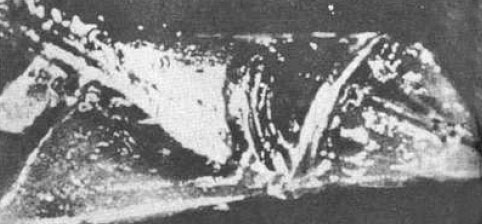
Fig 18.
This gold model of a Concorde is in the State Bank, Bogota.
It can’t be incorporated into any fish or bird cult. There weren’t
any!
(for more info click
above image)
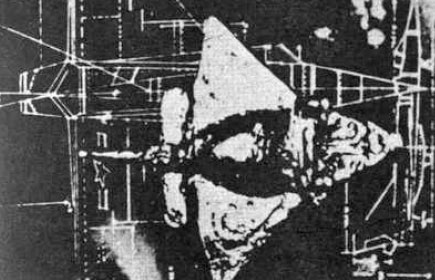
Fig. 19.
The Aeronautical Institute, New York,
made these technical
drawings after accurate testing in a wind tunnel.
(for more info click
above image)
For centuries archaeologists have cataloged the model at Bogota as a
decorative religious artifact. I’m sorry for the archaeologists, but
that simply won’t do. Aviation experts have seen the object and
tried it out in a wind tunnel. They believe it is a model aircraft.
Dr. Arthur Poyslee of the Aeronautical Institute, New York, says:
“The possibility that the artifact is meant to represent a fish or a
bird is very slight. Not only because this gold model was found deep
in the interior of Colombia and artists would never have seen a
saltwater fish, but also because one cannot imagine a bird with such
geometrical wings and high vertical fins.”
The front part is as clumsy as that of the heaviest U.S. B52. The
pilot’s cockpit lies directly behind the streamlined nose, protected
by a windscreen. The aircraft’s rear, heavy with the propulsion unit
it contains, rests in aerodynamic symmetry on two rounded-off wings.
(The model at Bogota has two delta wings like the Concorde and
terminates, like it, in a sharply pointed nose.) Two stabilizing
fins and the upright tail complete the Inca model aircraft (Fig.
19).
Who could be so dreary and unimaginative as to interpret these model
aircraft as birds or flying fish?

The constructors modified the
archaeologists’ “religious artifact” with these drawings!
In all ages gold was a rare and consequently precious metal; it was
found in temples and royal palaces. If an object was cast in gold,
it was because it had great value per se and also because it was to
be preserved for an indefinite period of time. Hence it was made of
a material that did not rust or corrode. Anyway, there was no fish
or bird cult to which these models could be attributed.
There is a
massive gold sphere (Fig. 20) with a broad flange round it, in the
cosmological treasury at the State Bank in Bogota. To anticipate
fatuous objections, it is not a sculptural representation of a hat
with a brim. Hats have hollow spaces for even the most stupid heads
to fit into.
In Gods from Outer Space, I showed - without contradiction - why I
consider that the sphere is the ideal
shape for spaceships or space-stations. Spherical bodies rotate in
space, thus creating an artificial
gravity for the crew in the cabins placed at the sphere’s
circumference. (Gravity is necessary for the
metabolism of the organs on lengthy journeys.)
The gold sphere once
again supports my contention that the sphere was the shape used for
celestial vehicles in distant ages.
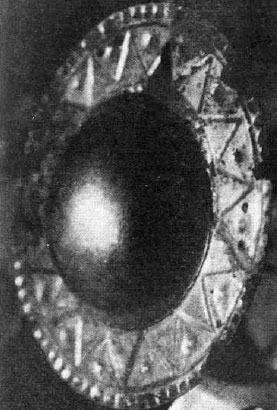
Fig 20.
There is a massive gold sphere in the cosmological treasure chamber
of the state Bank Bogota.
The broad flange could equally well be a
docking ramp for supply ships and a storeroom,
divided into cells,
for solar energy.
The technical possibilities we can imagine are
endless.
The negative in stone is in the Turkish Museum in Istanbul.
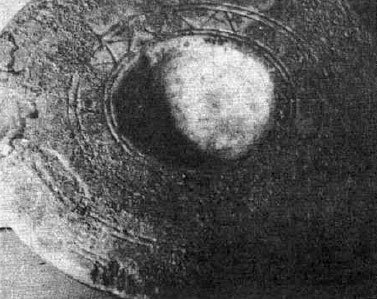
Fig. 21.
The matrix, the negative, of the golden space sphere from
Cuenca
is on show in the Turkish Museum at Istanbul!
In addition to serving as a docking ramp for supply ships, the broad
flange may also have been divided into cells to store solar energy.
The technical possibilities, we can imagine, are endless. At all
events, I should like to know how the matrix (Fig. 21) of this gold
sphere came to be in Turkey, 7,500 miles from Ecuador!
This find,
carved out of stone, is on show in the Turkish Museum, Istanbul. It
is the negative of the gold sphere in Bogota’s treasure: the same
sphere, the same notched pattern on the encircling rim.
The card
under the stone matrix in the first story of the Museum at Istanbul
says “Unclassifiable.” As long as science refuses to accept the idea
that flying machines could cross the oceans and cover the vast
distances between the continents as early as prehistoric times, its
rigid prejudice will find certain puzzles insoluble.
One cannot say that scholars have no
imagination, but the fact remains that they insist on new
discoveries fitting into accepted patterns.
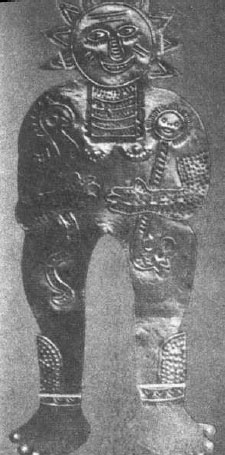
Fig. 22.
This copper figure, 20 inches high, has normal human
proportions, but only four fingers and four toes on hands and feet.
The serious scientific explanation?
An adding machine! Were the Incas
so stupid as to make a whole figure just to represent a “four”?
Really this is the “Star God.”
At Cuenca I photographed a copper object, some 20 inches high,
representing a figure of normal human dimensions (Fig. 22). An
abnormal feature is that he has only four fingers on each hand and
four toes on each foot. However, we also find representations of the
gods with some of their limbs missing among the ancient Indians, the
Maoris, the Etruscans and other peoples.
Yet I read in a serious
scientific publication how simple the solution of this mystery is.
Toes and fingers were a kind of adding machine. If the artist wanted
to express the number “19,” he left out one finger or one toe.
Pursuing this scholarly fantasy, the number “16” was represented as
a being with four plus four toes and four plus four fingers = 16!
This ingenuous way of counting seems to me to be unworthy of a
people who built roads and fortresses and cities.
Why, by the gods of all the stars, did the intelligent Incas have to
draw or sculpt a whole man with hands and feet to express the number
4? Deadly serious science gets entangled in the net of its own
fantasy. To be sure it admits that the Incas could count, but it
does not credit them with being able to represent “4” by four dots
or four dashes. So they had to lop off fingers and toes. O sancta
simplidtas!
As for the figure that is minus two fingers and two toes, the
explanation as a childish method of counting is unconvincing, for
according to Father Crespi, it is a representation of the “Star
God.” In his right arm the smiling sun god clasps an animal
combination of hippopotamus, parrot and snake, in his left, a staff
with his emblem, the laughing sun at the top and a decorative
snake’s head at the bottom. Star-like points surround the god’s
happy face and they can be seen, too, on his two colleagues from
caves in the Australian bush, the two “creators” (Fig 23).
They wear
overalls with broad straps around the chest.

Fig. 23.
These funny mythical figures, primeval inhabitants of
Australia,
known as the “two creators,” have the same star-like
points as the “Star God,”
which is “sold” to us as a calculating
machine.
At some time in the future, probably after the metal
library has been deciphered, it will transpire that figures with
anatomically inaccurate limbs are really pictorial representations
of traditional oral descriptions of phenomena from the cosmos that
were different.
The masterpiece of the Inca’s Diirer, Degas or
Picasso, is a metal plaque measuring 38 ½ inches by 19 inches by 1
inch. No matter how long one studies it, one keeps on making new
discoveries. I noted down what I found: a star, a being with a fat
paunch and a snake’s tail, a rat-like animal, a man in a coat of
mail and a helmet, a man with a triangular head from which rays
emanate, two faces, a wheel with a face peeping out of it, birds,
snakes, bald and hairy heads, a face that grows out of another one,
a snake with a face, two concentric circles with a face inside. A
veritable riot! Paired together amid all the disorder are two strong
gold “hinges,” which bring into prominence a face above a falling
bomb! (Fig. 24).
What was the artist trying to convey?
Was he a predecessor of Hieronymus Bosch?
Has he perpetuated the moment of the annihilation of earthly chaos
by the Star God?
The minute fraction of the treasure from the patio of the Church of
Maria Auxiliadora at Cuenca that I have illustrated here is a still
more minute fraction of the precious objects which rest undisturbed
in Juan Moricz’s tunnels, an orgy of human history in metal.
What were the Incas’ metal objects for, what was their purpose? Are
they simply expensive primitive toys?

Fig. 24.
One keeps on making new discoveries on this metal plaque,
which- measures 38 ½ inches by 19 inches by 1 inch.
A star, a being
with a fat paunch, a man in a coat of mail with a helmet, faces,
a
wheel with a face peeping out of it, a face with another one growing
out of it and ...
The whole chaotic scene is menaced by a falling
bomb,
which the artist emphasized by placing it between two hinges.
Or are they really messages from a very early age that we cannot
decipher?
Professor Miloslav Stingl is the leading South American scholar in
the Iron Curtain countries; he
graduated in the ancient civilizations of America. Today he is a
member of the Academy of Sciences
at Prague and author of archaeological and ethnological books. In
versunkenen Mayastadten (1971),
for example, is highly acclaimed.
Professor Stingl, who was a guest
in my house, saw the photographs
I had taken at Cuenca.
“If these pictures are genuine, and everything indicates that they
are, because no one makes forgeries in gold, at any rate not on such
a large scale, this is the biggest archaeological sensation since
the discovery- of Troy. Years ago I myself supported the view that
the Incas had no writing in the alphabetical sense of the word. And
now I’m faced with Inca writing! It must be very, very ancient,
because one can recognize the transition from ideograms to writing.”
“What do you make of the engravings? How do you fit them into the
existing system?”
“To be able to give a precise scientific verdict I
should have to subject each plaque to a detailed and lengthy
examination, and compare each one with material already available.
For the moment I can only say that I am dumbfounded. The sun was
often part of the scenery in known Inca engravings, but man was
never equated with the sun, as I see time and again in these
photographs. There are representations of men with sun’s rays round
their heads and there are men depicted with star points coming from
them. The symbol of ‘holy power’ has always been the head. But in
these pictures the head is simultaneously sun or star. That points
to new direct connections.”
“How would you interpret the bomb on the
plaque?”
The famous scholar took out a magnifying glass and examined the
photograph in silence for a long time.
“No interpretation is possible; all this is absolutely new.
Explained in totemistic terms, I would say the radiant figures with
the stars above and the snake symbols below indicate a connection
between heaven and earth. And that means that the stellar beings and
suns had a relationship with the inhabitants of the earth.”
“What else?”
“I cannot say any more. Of course, the solar wheel is well known,
but here it is not clear whether it is a solar wheel, for there is a
face inside it, which is quite contradictory. At all events, all the
figures, birds, snakes, helmeted figures and everything else that
can be seen on the plaque seem to originate from a dream world, from
a mythology.”
“A mythology that is daily acquiring a more tangible and realistic
background!”
The professor laughed: "I have to admit that you have
arguments in your jigsaw puzzle that disconcert even an old fox like
me and give me cause for reflection.”
Who is going to study the tunnels and treasures ‘Underneath Ecuador,'
who is going to bring this
sensational archaeological discovery into the searching light of
scientific examination? There does not
seem to be anyone available as rich and enthusiastic as Heinrich
Schliemann, who excavated Troy and
Mycenae. When Moricz discovered the tunnels he was as poor as a
church mouse. Since then he has
discovered iron and silver mines and leased them to metal firms to
exploit.
He has become
comparatively rich, but he lives extremely simply and uses all his
wealth for his research work. But Juan Moricz is not rich enough to
engage expert assistance and continue his work on the extended scale
that is essential.
He knows perfectly well that he could immediately get the help of
speculators, Wild West type gold-diggers; he would only have to show
them a fraction of the alluring gold treasures in the tunnels below
Ecuador. He does not want that kind of assistance. It would
degenerate into plundering and would not benefit mankind. That is
why it is difficult to organize’ a disinterested expedition that
would be exclusively devoted to research. Even in 1969 when Moricz
invited guests to visit the site, he had the group accompanied by
armed guards.
Moricz and Pena said that the further the group
penetrated into the labyrinth, the tenser and more febrile grew the
atmosphere, until finally the guests were afraid of the guards, who
had caught-gold fever. They all had to turn back. Why does Ecuador
do nothing to encourage a scientific expedition that would bring
fame to the country?
Ecuador, with its five million inhabitants, is one of the poorest
countries in South America. The plantations of cocoa, bananas,
tobacco, rice and sugar-cane do not bring in enough foreign exchange
for the purchase of modern technical equipment. Indian agriculture
on the plateau produces potatoes and corn, and there is some sheep
and lama breeding. The wild rubber obtained from the eastern forests
is no longer in demand.
Perhaps government-aided exploitation of
mineral wealth (gold, silver, copper, lead and manganese) may bring
in some income in the years to come, as may the petroleum found
offshore. But even then all the surplus will be used in the first
place to alleviate the wretched poverty; as yet the government shows
no interest in projects that do not directly help to overcome the
problem of hunger.
Juan Moricz estimates that inspection of the tunnel system alone,
without detailed research, would cost more than one million Swiss
francs. An electricity station would have to be set up, security
measures would have to be taken and some form of mining machinery
would be necessary. My knowledge of this buried treasure, which has
so much to tell us about human history, induces me to repeat the
challenge I issued in Chariots of the Gods? in 1968:
“A Utopian archaeological year is due! During this year
archaeologists, physicists, chemists, geologists, metallurgists and
all the allied branches of these disciplines would concentrate on
one question: did our ancestors receive visits from outer space?”
So that no individual or institution can say that it is out of the
question to go in search of nebulous mysterious caves, I reprint
lawyer Pena’s visiting-card. He will gladly put any serious
investigator in touch with Juan Moricz. (Fig. 25)

Fig. 25.
Lawyer Pena tells every serious research worker how to get
in touch with Juan Moricz!
The tunnels under Ecuador need detailed
investigation!
Nearby, in the Peruvian Andes, Francisco Pizarro (1478-1541)
discovered cave entrances closed with slabs of rock on Huascaran,
the mountain of the Incas, 22,203 feet above sea level. The
Spaniards suspected that there were storerooms behind them.
Speleologists did not remember these caves until 1971, when an
expedition was organized. The periodical Bild der Wissenschaft gave
an account of the expedition which descended in the neighborhood of
the Peruvian village of Otuzco equipped with all the latest
technical equipment (winches, electric cables, miner’s lamps and
hydrogen bottles).
Two hundred feet below the earth the scientists
made a staggering discovery.
At the far end of caves which had several stories they suddenly
found themselves confronted with water-tight doors made of gigantic
slabs of rock. In spite of their tremendous weight, four men were
able to push the doors open. They pivoted on stone balls in a bed
formed by dripping water.
Bild der Wissenschaften reported as
follows:
“Vast tunnels, which would leave even modern underground
constructors green with envy, began behind the ‘six doors.’ These
tunnels lead straight towards the coast, at times with a slope of 14
per cent. The floor is covered with stone slabs that have been
pitted and grooved to make them slip-proof. If it is an adventure
even today to penetrate these 55- to 65-mile-long transport tunnels
in the direction of the coast and finally reach a spot 80 feet below
sea level, imagine the difficulties that must have been involved in
the fourteenth and fifteenth centuries in transporting goods deep
under the Andes to save them from the grasp of Pizarro and the
Spanish Viceroy.
The Great Ocean lurks at the end of the underground
passages of ‘Guanape,’ so called after the island that lies off the
coast of Peru here, because it is assumed that these passages once
led under the sea to this island. After the passages have gone
uphill and downhill several times in pitch darkness, a murmur and
the strangely hollow sounding noise of surf is heard. In the light
of the searchlight the next downhill slope ends on the edge of a
pitch black flood which is identified as seawater. The present-day
coast also begins here underground. Was this not the case in former
times?”
Scholars think that a search on the island of Guanape would be
pointless, because there is nothing
there to indicate that a passage from the mainland ever emerged on
to it.
“No one knows where these
subterranean roads of the Incas and their ancestors end or whether
they lead the way to the bursting
treasuries of worlds that vanished long ago.”
Francisco Pizarro and his rapacious followers had already suspected
that gold treasures existed in impenetrable Inca hiding places. In
1532 the noble Spaniard promised the Inca ruler Atahualpa his life
and freedom if he filled two-thirds of a room measuring 23 by 16 by
10 feet with gold. Atahualpa believed the word of the ambassador of
Her Christian Majesty Juana the Mad (1479-1555). Day after day the
Incas fetched gold until the room was filled to the required height.
Then Pizarro broke his word and had Atahualpa executed (1533).
In the same year the Spanish Viceroy elevated the Inca Manco Capac
to the rank of shadow king. (He, too, was murdered by the Christian
conquerors in 1544.) His death saw the end of the Inca dynasty,
which had entered history with its legendary founder of the same
name. According to the historians, 13 “Sons of the Sun” are supposed
to have ruled the Inca kingdom between the first and the last Manco
Capac. If we date its historically established beginning to around
A.D. 1200 and its end to 1544, the year when the last sun king died,
then this mighty empire that stretched from Chile to Ecuador, from
the Andes north of Quito to Valparaiso in the south, must have been
built up in barely 350 years.
During this period, the first
pre-Columbian empire in South America must have been welded
together. For the conquered territories and peoples were not
considered as occupation zones, but were integrated into the
prevailing constitution. Progressive achievements in agriculture
were passed on by trained officials, as were the smoothly
functioning rules of a communal economic order.
-
Did the Incas equip
a network of 2,500 miles of well-built roads with rest-houses during
the same span of time?
-
Did they simultaneously build cities such as
Cuzco, Tiahuanaco, Macchu Picchu, and the cyclopean fortresses of
Ollaintaytambo and Sacsahuaman?
-
Did they also lay down water mains
and work silver, tin and copper mines, whose products they alloyed
to make bronze?
-
And did they develop the goldsmith’s art, weave the
finest cloth and make pottery with noble shapes “on the side,” as it
were?
I hardly dare speak of the high culture which they nurtured in
addition during this limited 350 year period. But if it was not the
Incas but their ancestors who should be credited with these
wonderful achievements, surely the culture and tool technology of
the pre-Inca peoples must have been higher than the Incas who came
after them.
No, the chronology cannot be blindly pasted together like that,
because there are so many indications to turn the arbitrary
(re-)construction upside down.
I assert that the tunnel system existed thousands of years before
the Inca kingdom came into being. (How and with what tools are the
Incas supposed to have built hundreds of miles of passages deep
under the earth? The Channel tunnel has been planned by the
engineers of our highly technological century for fifty years and
they still have not decided which method should be used to build
this comparatively minor tunnel.)
I assert that the age-old tunnel systems were known to the Inca
ruling classes. (After Atahualpa’s murder, the last Manco Capac
ordered the metal treasures scattered throughout the kingdom to be
collected in the Temple of the Sun and deposited in the existing
caves, which were known to him, to keep them safe from the white
invaders.)
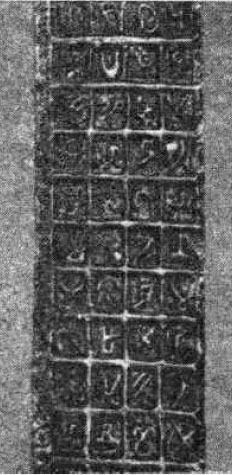
Fig. 26.
This metal stele is the showpiece. It is 20 ½ by 5 ½ by 1 ½
inches.
Fifty-six different characters are “stamped” on its 56
squares.
The folios of the metal library in the Great Hall have
exactly the same signs! Did the maker of this stele know a code,
an
alphabet with 56 signs or symbols, which were arranged to form
writing?
Until now it has been claimed that there were no scripts
using alphabets in the South American cultures.
I assert that the metal treasures under Ecuador and Peru came from a
period long before the rise of the Inca kingdom and its culture.
About 1570 the Spanish chronicler Pater Cristobal de Molina tried to
fathom the motives behind the Incas’ tunnel building. In his book
‘Ritos y Fabulas de los Incas’, published in 1572, Molina tells us
that the original father of mankind withdrew into a cave after he
had done his work, i.e. after the creation was completed. But this
secret retreat became the birthplace of many peoples who had
appeared out of an “endless night.”
Molina related that these caves
were also used for generations as treasuries for hiding the peoples’
wealth whenever they were oppressed. Absolute secrecy in the circles
who knew about the caves was an iron law, non-compliance with which
was punishable by death. (How potent this law still is today I was
able to experience on my journey through Ecuador in the year of
grace 1972.)
Let
the Vatican grail guardian Father Crespi of Cuenca be the key
witness to the pre-Christian origin of the metal treasures. He said
to me:
“Everything that the Indians brought me from the tunnels dates to
before Christ. Most of the symbols and pre-historic representations
are older than the Flood.”
Three kinds of treasure await excavation in the tunnels and halls
under Ecuador and Peru:
-
The inexhaustible legacy of the
builders of the actual tunnels
-
The stonemason’s work of the first intelligent men, who were
presumably pupils of the tunnel constructors
-
The gold and
silver treasures of the Incas that were hidden here from the Spanish
Conquistadors after 1532.
But the question of questions is: Why were the tunnels built?
Back to Contents
|


























